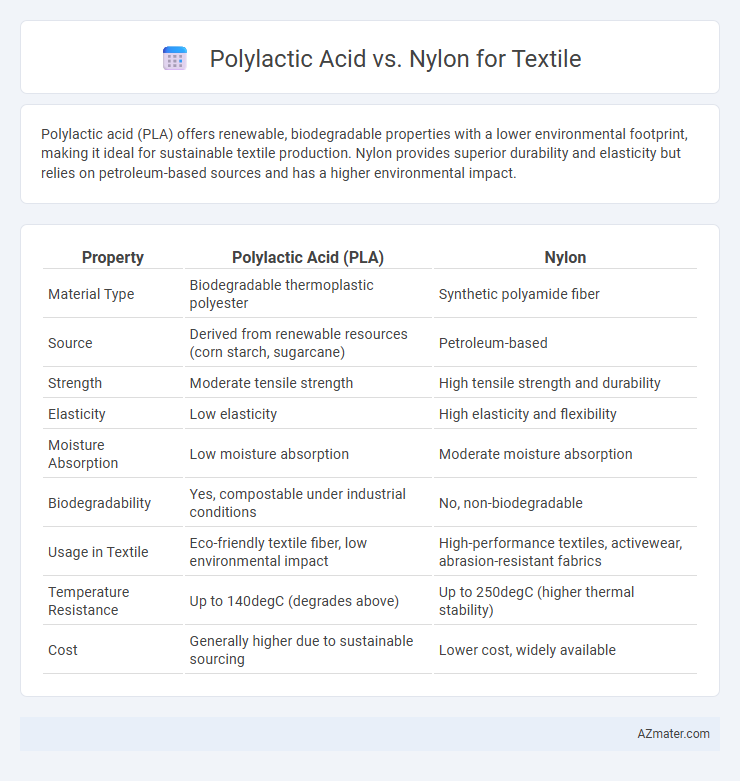Polylactic acid (PLA) offers renewable, biodegradable properties with a lower environmental footprint, making it ideal for sustainable textile production. Nylon provides superior durability and elasticity but relies on petroleum-based sources and has a higher environmental impact.
Table of Comparison
| Property | Polylactic Acid (PLA) | Nylon |
|---|---|---|
| Material Type | Biodegradable thermoplastic polyester | Synthetic polyamide fiber |
| Source | Derived from renewable resources (corn starch, sugarcane) | Petroleum-based |
| Strength | Moderate tensile strength | High tensile strength and durability |
| Elasticity | Low elasticity | High elasticity and flexibility |
| Moisture Absorption | Low moisture absorption | Moderate moisture absorption |
| Biodegradability | Yes, compostable under industrial conditions | No, non-biodegradable |
| Usage in Textile | Eco-friendly textile fiber, low environmental impact | High-performance textiles, activewear, abrasion-resistant fabrics |
| Temperature Resistance | Up to 140degC (degrades above) | Up to 250degC (higher thermal stability) |
| Cost | Generally higher due to sustainable sourcing | Lower cost, widely available |
Introduction to Polylactic Acid and Nylon in Textiles
Polylactic acid (PLA) is a biodegradable, bio-based polymer derived from renewable resources like corn starch, widely used in textiles for its eco-friendly properties and excellent moisture-wicking ability. Nylon, a synthetic polymer made from petrochemical sources, is valued in textiles for its high tensile strength, elasticity, and durability, making it suitable for performance and activewear fabrics. Both materials offer distinct advantages in textile manufacturing, with PLA emphasizing sustainability and nylon providing superior mechanical performance.
Origin and Production Processes
Polylactic acid (PLA) is a biodegradable thermoplastic derived from renewable resources like corn starch or sugarcane through fermentation and polymerization, making it an eco-friendly textile option. Nylon, a synthetic polymer invented in the 1930s, is produced from petrochemicals via a condensation polymerization process involving hexamethylene diamine and adipic acid. The production of PLA emphasizes sustainability and reduced carbon footprint, whereas nylon manufacturing relies on fossil fuels and involves higher energy consumption and greenhouse gas emissions.
Mechanical Strength and Durability Comparison
Polylactic acid (PLA) exhibits moderate tensile strength but lower elongation at break compared to nylon, which offers superior mechanical strength and elasticity, making it more resistant to stress and deformation in textile applications. Nylon's durability is notably higher due to its excellent abrasion resistance and long-term resilience against environmental factors such as moisture and UV exposure, whereas PLA tends to degrade faster under similar conditions. For textiles requiring high mechanical performance and longevity, nylon remains the preferred material, while PLA is suitable for biodegradable, lower-stress use cases.
Environmental Impact and Sustainability
Polylactic acid (PLA) fibers, derived from renewable resources like corn starch, offer biodegradability and lower carbon emissions compared to petroleum-based Nylon, making PLA a more sustainable choice for textiles. Nylon production involves significant energy consumption and releases nitrous oxide, a potent greenhouse gas, contributing to environmental pollution and a larger carbon footprint. PLA's compostability and reduced reliance on fossil fuels position it as an eco-friendly alternative in the pursuit of sustainable textile materials.
Moisture Management and Breathability
Polylactic acid (PLA) fibers exhibit superior moisture-wicking properties compared to nylon, enhancing comfort by efficiently transporting sweat away from the skin. PLA's hydrophilic nature allows better breathability and faster drying times, making it ideal for activewear and performance textiles. Conversely, nylon's hydrophobic fibers tend to retain moisture longer, which can reduce ventilation and increase clamminess during intense physical activity.
Dyeability and Color Retention
Polylactic acid (PLA) exhibits excellent dyeability due to its hydrophilic nature, allowing vibrant and uniform color absorption, whereas nylon requires specialized dyeing techniques, such as acid dyes, to achieve comparable results. PLA fibers retain color well through multiple washes because of their crystalline structure and low moisture regain, minimizing color fading or bleeding. Nylon's color retention, while strong due to its synthetic polymer structure, can suffer from higher moisture absorption, leading to potential dye leaching and diminished vibrancy over time.
Skin Compatibility and Comfort
Polylactic acid (PLA) fibers offer excellent skin compatibility due to their biocompatibility and hypoallergenic properties, making them ideal for sensitive skin in textile applications. Nylon, although durable and moisture-wicking, can sometimes cause irritation or discomfort for individuals with sensitive skin because of its synthetic composition. PLA's breathability and moisture management enhance overall comfort, outperforming nylon in terms of softness and reduced skin irritation during prolonged wear.
Cost Efficiency and Market Availability
Polylactic acid (PLA) offers cost efficiency through its renewable bio-based origin, often resulting in lower production expenses compared to petroleum-derived nylon, whose price fluctuates with oil markets. Nylon dominates market availability due to its established supply chains and versatile applications across textiles, while PLA's presence is expanding but remains less widespread in commercial fabric production. Cost-effective scalability of PLA depends on advancements in biopolymer manufacturing, whereas nylon benefits from mature industrial processes ensuring consistent supply and affordability.
Applications in the Textile Industry
Polylactic acid (PLA) is increasingly used in eco-friendly textile applications such as activewear, upholstery, and disposable garments due to its biodegradability and moisture-wicking properties. Nylon remains dominant in performance textiles, including outdoor apparel, sportswear, and industrial fabrics, valued for its high tensile strength, abrasion resistance, and elasticity. The contrast in applications highlights PLA's suitability for sustainable, low-impact products, while Nylon excels in durability and technical performance in demanding textile uses.
Future Trends and Innovations
Polylactic acid (PLA) is gaining traction in the textile industry due to its biodegradability and renewable sourcing from corn starch, positioning it as a sustainable alternative to traditional nylon fibers derived from petrochemicals. Innovations in PLA production focus on enhancing fiber strength, moisture management, and dyeability to meet performance standards comparable to nylon, which remains favored for its durability and elasticity. Future trends indicate increased integration of PLA blends with engineered nanomaterials and bio-based additives to improve thermal regulation and UV resistance, addressing the growing demand for eco-friendly, high-performance textiles in fashion and technical applications.

Infographic: Polylactic acid vs Nylon for Textile
 azmater.com
azmater.com